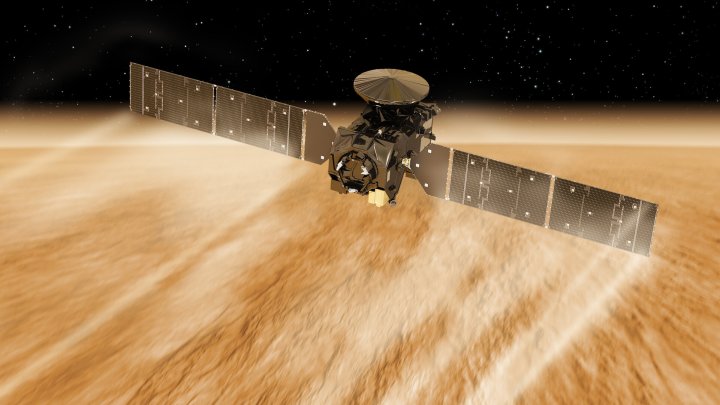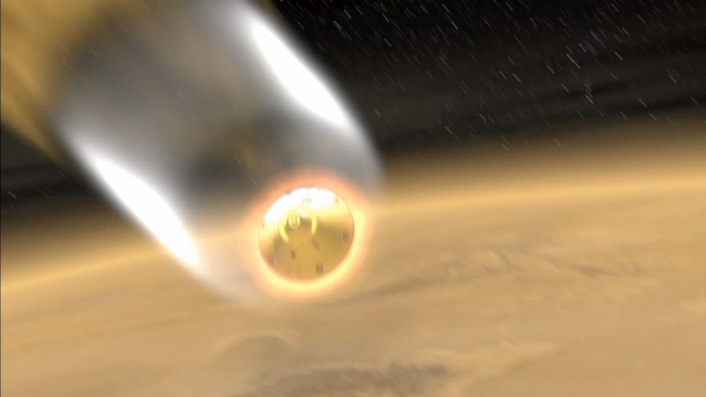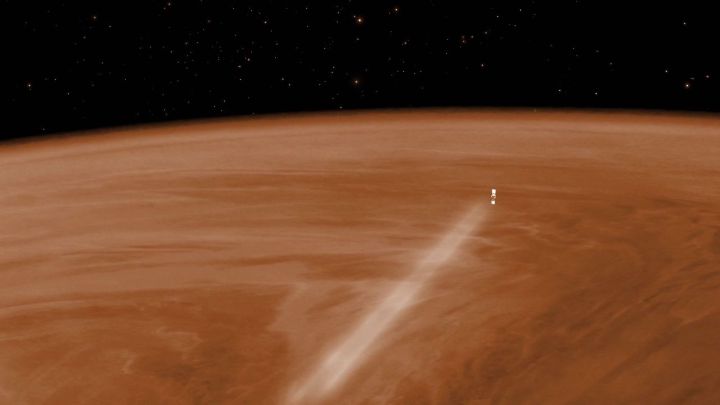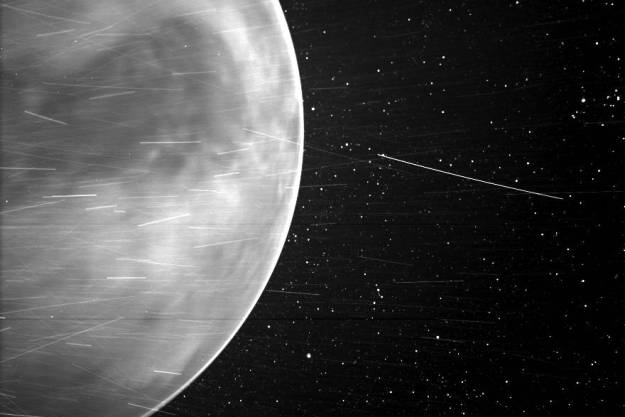If you’ve been following space news recently, you’ve probably heard about Mars Sample Return — NASA’s ambitious plan to collect samples of Martian rocks and bring them back to Earth for study. That mission is scheduled to launch later this decade, but it will be a years-long and extremely expensive process to collect and retrieve those samples.
But Mars isn’t the only planet within visiting distance. Why don’t we hop over to our other planetary neighbor, Venus, and collect a sample from there as well?
That’s just what is being proposed by a group of Venus researchers. We spoke to the leader of the proposal group to learn more.
An old idea whose time has come
Scientists have been discussing the merits of trying to nab a sample from Venus for decades, with mission concepts studied as far back as the 1980s. Although Mars has been the planet that has received the most attention in recent years, there’s a strong interest in the planetary science community in learning more about Venus — particularly because it could help us understand more about other planets outside our solar system.
Now that could be changing, as NASA kicks off the decade of Venus with a pair of missions set to visit there, along with a European Space Agency mission, all scheduled for the next decade.

Previous Venus sample missions never got off the ground for a few reasons: the focus on Mars over Venus, the lack of technology to enable such a complex operation, and the essential inhospitality of Venus. Venus is hot, with an extremely dense atmosphere, creating a very harsh environment for electronics to operate in.
Trying to fly to Venus, send a probe down to the surface, collect a sample, get that sample back up to orbit, and then return it to Earth would be both prohibitively expensive and would require significant technological developments.
That’s why a group of French researchers has a different approach. Instead of trying to collect a piece of Venus’s surface, we should try to grab some of its atmosphere. The Venus Atmospheric Sample Return mission or VATMOS-SR is a mission concept by a group at the Paris Institute of Planetary Physics, who are trying to drum up support for their idea.
The great advantage of this approach is its relative simplicity. There’s no need to land anything on the surface or to get back to orbit. Instead, you could send one spacecraft on a path away from Earth and toward Venus, where it would enter the atmosphere and fill bottles with around four liters of gas. Then it would keep on traveling right back to Earth.
The spacecraft would have no instruments and take no readings. It would just be a collection vehicle. That makes it safer, easier, and cheaper, lead researcher Guillaume Avice explained to Digital Trends.
“You just skim through the atmosphere on a ballistic trajectory,” Avice said. “So it just takes one year to go there, to take your sample, and to get back to Earth.”
Planning for the long term
These days, planetary science missions typically involve sending instruments (such as those on the Mars rovers) to a location and having them take measurements. This approach advocates collecting material and bringing it back to Earth instead, where we have much more capable and varied instruments to investigate with.
And with a precious sample from another planet, a little goes a long way. A sample of several liters of gas could keep scientists busy for years.
“What is really cool is that you get a lot of gas and you can measure it, not forever, but for a long time on Earth,” Avice explained. “If you think about it, you can preserve a little bit of that sample. Maybe in a decade, we’ll have a new spectrometer on Earth which will be useful for this sample.”
This planning for the future makes sense when you look at how NASA has approached the lunar samples collected during the Apollo missions to the moon. Some samples were analyzed as soon as they were returned to Earth, but others were stored on the basis that future technology would allow them to be analyzed in new depth. And that long-term approach has paid off, with a 50-year-old sample opened just last year and revealing information about the moon’s geology and history.

If we were able to take a similar sample of the Venus atmosphere, much of it could be stored for the long term too. And researchers would benefit from even just a handful of atoms of a gas sample, so a sample of several liters would be enough to provide research materials for the entire Venus community.
An upcoming mission to Venus called Davinci plans to make similar measurements of the atmosphere, but in this case, there’s a real time crunch. The mission involves dropping a sample sphere through the atmosphere, so samples have to be taken and processed within just one hour.
This has caused problems with previous Venus missions in earlier decades, which resulted in garbled findings likely due to incorrect calibrations or clogged vents. Engineers do their best to anticipate any possible problems with sampling, but that’s hard to do when there are so many unknowns about the environment a mission is entering.
If a sample is brought back to Earth, however, there’s plenty of time for calibrating instruments and double-checking results, making findings more reliable.
There are some complexities with taking a sample at very high speeds. A process called fractionation occurs which can split a sample into different parts when it is collected so fast, but it should be possible to correct for that.
How the atmospheric sampling mission would work
There are good reasons that no one has attempted a Venus sample return mission before though. Because it isn’t easy.
The obvious parallel to a Venus sample return mission would be the Mars Sample Return mission, an upcoming joint venture between NASA and the European Space Agency which is slated to launch in the late 2020s. This plan to collect a sample from Mars involves multiple rovers, landers, or helicopters, is decades in the making, and has a ballooning budget that has even ardent Mars enthusiasts concerned.
And Venus is even more inhospitable than Mars, with its thick atmosphere, clouds of sulfuric acid, and pressure comparable to the depths of the ocean. An attempt to return a sample from the surface of Venus would be a “nightmare,” Avice said, and “probably even more expensive than on Mars.”
That’s why Avice’s group is proposing scooping up a sample from the planet’s atmosphere instead. “It’s super cheap,” he said, relatively speaking: The group estimates the cost of such a mission as 100 million Euros ($110 million), compared to the $8 to $9 billion current estimates for Mars Sample Return.
Even with the relative ease of an atmospheric sample, however, not any old bit of the atmosphere will do. At very high altitudes, the atmosphere is extremely thin, and some molecules are separated out by gravity. So to get a representative sample, you need to go below a level called the homopause, below which the atmosphere is sufficiently well mixed to contain all the different molecules present.
At Venus, the homopause is around 110 km (70 miles) from the surface, so the mission needs to reach below that level. But the deeper you go, the harder the mission becomes. “So the target is to be just below the homopause, with some safety margin,” Avice said. “If we go deeper it becomes much more challenging and expensive.”
The challenges
Even just getting through the planet’s atmosphere is difficult, however. One big challenge is the issue of keeping the spacecraft safe from the tremendous heat which builds up due to friction in the atmosphere.
Spacecraft which are going to be entering the atmosphere of a planet — whether that’s visiting another planet like Mars or a spacecraft returning to Earth through our own planet’s atmosphere — have a thick heat shield that protects the delicate components inside from the very high temperatures.

Delivering a rover to Mars, for example, involves wrapping the rover in a heat shield, and then sealing the entire thing — rover and heat shield together, along with thrusters and other spacecraft parts — into the nosecone of a rocket for launch. Once in space, the spacecraft is deployed and travels to Mars, then the heat shield protects the rover as it passes through the atmosphere to land.
For an atmospheric sample mission, however, you would need one heat shield to work twice — both during the sampling at Venus, and again when returning the sample to Earth. It’s not clear if current heatshield technology would be up to the task of protecting a spacecraft through two such exposures.
Getting a heat shield to work twice is “something that we don’t really know how to do,” Avice said. And it might require years of development to work, if it’s even possible.
What to do with the sample once it’s back on Earth
Another challenge is a surprising one. You might think that collecting a sample is the hard bit, and analyzing it once it is back on Earth would be easy. But it turns out that working with gas samples is harder than you might imagine.
The Venus atmosphere is full of substances that easily evaporate, called volatiles. These include noble gases and compounds including nitrogen, hydrogen, carbon, and sulfur. Studying these is key to understanding Venus’s atmosphere, but they aren’t easy to transport or study.
To properly trap a volatile in a sample bottle, you need a very good valve — both so that none of the sample escapes, and so that none of the gases from other environments like Earth’s atmosphere leak in. This was a problem for the Hayabusa2 mission which managed to return a sample from an asteroid but did experience a leaking in of Earth atmosphere likely caused by the shock of the parachute deployment during its return to Earth.

Even if the sample makes it back to Earth completely pristine, with no leaks whatsoever, you still need to move fast to transfer the sample from its bottle to a more secure container. Even the tightest valves will leak a bit over months of time, so you need a system of multiple containers which can capture anything which does leak from the sample and preserve as much of it as possible.
Researchers are developing vacuum systems to extract and analyze gases, including those used for the Hayabusa2 sample, but this is still a new area of technology that needs to be developed for an atmospheric sample return mission to be fully effective.
The future of planetary science: in situ vs. sample return
The atmospheric sampling mission is still firmly in the concept stage, and the group is hoping to get it picked up in the next round of proposals for the European Space Agency or perhaps NASA.
It’s an ambitious plan, but it’s not as outlandish a concept as it would have been a few years ago. “Decades ago, sample return was just a dream and not really serious,” Avice said, But now with previous missions like Hayabusa2 and upcoming missions like Mars Sample Return, it’s becoming a real possibility.
And there’s the potential to show that sample return can be done relatively quickly and cheaply, because of the trajectories that are possible between Earth and Venus and because a spacecraft wouldn’t have to slow down, get to the surface, and get back to orbit before returning to Earth.
The mission could potentially be a quick whip back and forth, returning a sample within a year.
“What is really cool is that we would get a Venus atmosphere sample before we get samples from Mars,” Avice said. “So that would be the first sample from another planet.”
Editors' Recommendations
- Here’s why scientists think life may have thrived on the ‘hell planet’ Venus
- Inside the Vera C. Rubin Observatory, home of the world’s largest digital camera
- Rocket Lab plans to send the first private mission to Venus
- MIT researchers detail plans for private missions to search for life on Venus
- NASA video shows you what it’s like to plunge through Venus’ atmosphere




